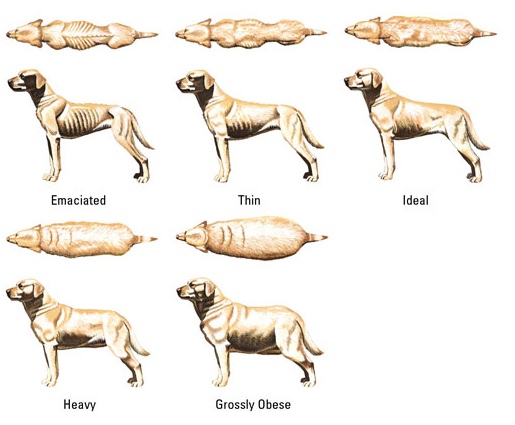In the next few blogs, we will discuss certain medical issues that our dogs are subject to. The first issue we will discuss is obesity.
Did you know more than half of the dog population is overweight? It may not be a surprise to you with the increase of overweight adults and children in our country. Unfortunately, dogs and children depend on their owners and parents to assist with their health and nutrition.
Canine obesity can lead to many other serious health issues, such as diabetes, arthritis, high blood pressure and hypothyroidism. Dogs can also suffer from cardiorespiratory diseases, endocrine disorders like Cushing’s, exercise intolerance, decreased immune functions and orthopedic disorders.
The most obvious signs your dog is overweight are:
– A large body relative to the legs.
– Excess fat around the neck and underside of the belly.
– Round appearance, especially when viewed from above (see picture above).
Other signs include decreased activity level, difficulty climbing stairs and excessive panting during activity.
Scientists have found a link between obesity and certain genes. Dogs with these particular gene variants have an increased 20%-30% chance of becoming obese. Certain breeds have been identified as genetically predisposed to obesity including bassetts, boxers, dachshunds, Labs, beagles and other retrievers. However, just because is a dog is predisposed does not mean the dog will be obese.
When we talk about obesity we first need evaluate a dog’s nutrition and exercise. Exercise is important for a dog’s overall health but without the right nutrition a dog could still suffer from obesity.
Obsesity is an inflammatory condition. Food sensitivities are a major cause of cellular inflammations. During this process, the gut lining becomes inflamed which allows foreign invaders, such as bacteria, to cross into the bloodstream. This way inside the immune system will cause system-wide inflammation.
If you find that your dog needs to lose weight we don’t suggest that you go out and buy a low fat or senior kibble. What we do suggest is determine how many calories your dog should be getting each day.
The first step is to determine your dog’s ideal weight in kilograms. To do this take your dog’s ideal weight in pounds and divide by 2.2 (a vet will be able to help you determine ideal weight). Next, you will determine your dog’s Resting Energy Requirements (RER) based on his ideal weight. Take your dog’s ideal weight in kg and multiply by 30 and then add 70. For example:
We have an ideal weight of 40lbs. Weight in kg is 18.18. Then 18.18 x 30 = 545.45 + 70 = 615.45. So this dog’s RER would be 615 calories/daily.
Now that we know the dog’s RER we will check out the below chart to calculate his MER (Maintenance Energy Requirements).
| Weight loss | 1.0 x RER |
| Neutered adult, normal activity | 1.6 x RER |
| Intact adult normal activity | 1.8 x RER |
| Light work or play | 2.0 x RER |
| Moderate work or play | 3.0 x RER |
| Heavy work or play (agility) | 4-8 x RER |
| Pregnant dog (first 42 days) | 1.8 x RER |
| Pregnant dog (last 21 days) | 3.0 x RER |
| Lactating dam | 4-8 x RER |
| Puppy, weaning to 4 months | 3.0 x RER |
| Puppy, 4 months to adult size | 2.0 x RER |
| Geriatric dog | 1.4 x RER |
Keep in mind this is only a guideline. Learn to adjust your dog’s caloric intake on a daily basis and take into consideration breed, age, health status, lifestyle and even the thickness of their coats. Once your dog has reached his ideal weight you will then adjust his caloric intake to determine his new MER.
We don’t recommend that you necessarily feed the recommended amount on your dog’s kibble bag. You should look at the kcal/cup and determine what the correct amount is for your particular dog’s need. Also, keep in mind that not all calories are equal and you should be aware of the pro-inflammatory ingredients such as artificial colors, flavors and preservatives, added antibiotics and hormones, sugar, levels of pesticides and GMO foods, as well as high-glycemic carbs. Click here to read about the good carbs you should feed your dogs.
There are certain fat-fighting, anti-inflammatory functional foods you can add to assist with weight loss:
– High quality, bioavailable novel protein. Ideal weight loss regimens are high in protein with moderate fat and restricted carbohydrates.
– Coconut Oil (virgin, expeller-pressed, preferably organic).
– Omega-3 fatty acids.
– L-Carnitine.
– White kidney bean extract. Do not feed raw kidney beans, as they are potentially toxic. Be sure to purchase your extract from a reputable source that uses a standardized extract process with heat. Should be given 10 minutes before meals. 500mg extract daily for small dogs, 1000mg daily for medium dogs and 1500mg daily for large dogs.
Finally, I want to advise against feeding prescription weight loss kibble. Most of these kibbles are high in carbs (and not the good kinds), contain pro-inflammatory ingredients and don’t contain enough high quality, bioavailable animal protein. One of the most popular weight loss foods contain corn gluten meal, soybean oil, whole grain corn and whole grain wheat. In our previous blogs we mentioned how wheat and corn actually promote storage of body fat.
If your dog has a lot of weight to lose we recommend doing it in a step-wise fashion of 5% every three weeks. We also recommend that you consult with a canine nutritionist to assist with meal development.
Information adapted from Canine Nutrigenomics – The New Science of Feeding Your Dog for Optimum Health by W. Jean Dodds and Diana Laverdure.
